Birdingpals Trip Report
Ethiopia trip March 2007
by Knud Rasmussen
At the end of 2006, I started to think about my next birding trip to meet the Pals. I was thinking about Africa, since I had never been there and at that time, Brendan Sloan, a Birdingpal from London, England was co-ordinating a trip to Ethiopia for the South African tour company “Rockjumper”.
I had heard many stories about traveling in Africa and decided, I would have to abandon my independent way of traveling and join an organized group.
My research interested me in Ethiopia, not only as one of the top birdwatching places in Africa, but also as the only country, which had never really been colonized and had therefore maintained much of its tribal culture.
I signed up, made the down payment, bought my airline ticket and obtained a visitor visa from the Ethiopian embassy in Ottawa, just to have the trip cancelled by “Rockjumper” three weeks before our scheduled departure. After initially panicking, Brendan and I decided to get together, hire a local Birdingpal guide, and go ahead with our trip. Since I already had an airline ticket with a set departure time, we decided to go with Meseret Mekuria, who happened to be available at that time. We agreed upon a 19 day itinerary, and we even saved a couple of hundred dollars over our originally planned trip. When all the details were ironed out, I had almost a week in Addis Abba before Brendan would arrive, and we could begin our birding.
I left Toronto on March 02 and flew via Amsterdam. I arrived in AA (as the natives call Addis Abba) the next evening, after a long flight. The custom officer was very interested in the scope I had packed in my suitcase and wanted to see it. This was not an easy task, as I had tightly packed a small suitcase with all my belonging for the entire trip. Luckily, after seeing it, along with the book, “Birds of Africa south of the Sahara” and he let me go, although he was obviously puzzled by the idea of bird-watching. Meseret, the guide I had hired, had made arrangement for a driver to pick me up and take me to the Ghion hotel, where I promptly went to sleep, as soon as I had checked in.
March 04 to 09
The Ghion (http://www.ghionhotel.com.et/) was interesting. It was built in the middle of AA on one of Emperor Haile Selassie’s old palace grounds. It was a bit tired, and had pre cold war architecture, but the garden was beautiful, very large, and full of birds. The staff was also very friendly.
I birded the grounds every morning before breakfast, and saw many Hooded and Egyptian Vultures, Black and Yellow-billed Kites and Pied Crows flying about or roosting in the large trees. The monkeys were sometimes being harassed by the crows. Sunbirds and Flycatchers were just a few of the many birds to be seen while walking the garden in the morning. The endemic Wattled Ibis feed on the lawns or roost in the trees. For such a large city, the air was surprisingly clean and there was little noise, with the exception of the priests and the mullahs calling the faithful to morning services. I didn’t need an alarm clock there, as the sounds waken everyone around 0600 every morning. After breakfast Meseret Mekuria, the local guide we had hired for the tour, arrived and I felled comfortable with him right away promising a good trip. We discussed the final details, and I spent the rest of my week in AA, waiting for Brendan’s arrival.
While I was there, I had the opportunity to meet several other local Birdingpals. One of them arranged for Arayi, a young tour guide, to show me around for a day. We decided to walk the streets filled with many small shops and street vendors selling local produce.
"The Ghion garden."
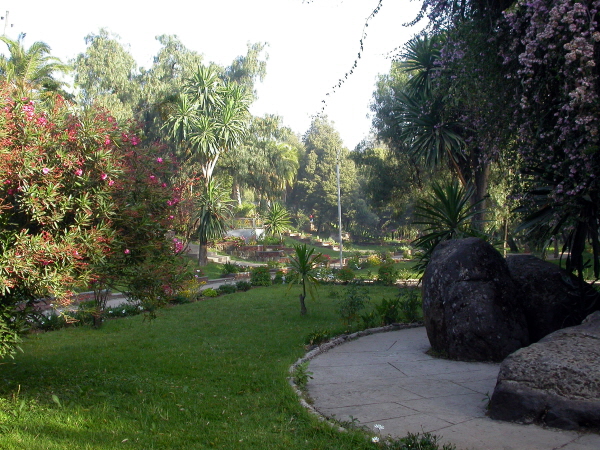
Eventually we reached the National Museum, a must for any visitors, because of Lucy, the remains of one the oldest human ever discovered. Considering the extent of Ethiopia’s history, it is a very small museum. It contains a few items from the old
Empire, and some of the famous artist, Debre Hayq’s paintings. You can’t help but think about how many national treasures must have been lost or sold. Many well-behaved school children in uniforms are gathered around their teacher, paying attention to every word. Some of them come over to shake hand with the faranji (foreigner) and want to know where I am from.
The hotel had several restaurants, including one that served native food, so I had to try the famous injera (kind of pancake).
To impress the waiter, I ordered one of the local delicacies, tongue and tripe. He tried to talk me out of it, thinking I did
not know, what it was, and that it would be too spicy. I managed to convince him, that I could eat it. Together with a local
beer it was OK, but I do not think, I will go out of my way for injera in the future.
I tried to use the hotel’s internet but soon gave up. It was just too slow for what I wanted to do, and I never found another place I could use the internet during the whole trip. I am almost sure the government did not want internet to be too successful and people told me that test messages on cell phones was banned.
One afternoon, I went for a walk outside the hotel compound and quickly had an unpleasant surprise. A young man bumped into me, and I realized very quickly that the local pickpocket had done his job on me. If you walk the streets alone in AA make sure you protect your wallet. I told the hotel manager about my problem, and he was kind enough to go down and talk to the old men, who were always sitting around drinking coffee, to see if they could find my wallet, as the pickpocket was only interested in
money, and usually throw the rest of the wallet away, but no such luck.
Brendan arrived early morning March 9 and we went birding in the garden (found two more endemics). After breakfast, Meseret and Yilma (also a local Birdingpal guide) arrived, and we finalized the last few details prior to starting out tomorrow.
Day 1 - March 10
We got up early, ate breakfast and got ready to depart for Debre Libanos Gedam. After checking out of the hotel we met Tariku, our driver for the entire trip.
We drove north on Highway 3 and birded all the way up to Muke Tur. We saw many new birds on the way, such as Hamerkop, and African Sacred Ibis.
We were driving through rural Ethiopia, and as soon as we stopped to bird, the locals show up as if from nowhere. We assume that they are not used to birders, and that we had better get used to company.
While birding at a small river, we spotted our first Nile crocodile sleeping on the bank.
These are Christian settlements, and then we arrive at Debre Libanos monastery and church. We got out of the car and walked behind the church and cemetery, where some of the last forest still exists. As we searched for a peculiar fruit eating bird, the endemic White-cheeked Turaco, an odd looking bird, showed up almost immediately, drinking water from a leaking water pipe.
We continued north, finding Gelada Baboons or “bleeding heart baboons”, and many more birds before arriving at a new eco-lodge under construction. Almost right way we spotted the first Lammergeyer flying just above our heads. Then, a Verreaux’s Eagle flew by. Finally, we spotted the bird we were after: Ruppell’s Black Chat, endemic to Ethiopia.
This was not tourist country and our “motel” in Muke Tur was the only one in town. Most of the other guests seemed to be truck drivers. It was primitive, but we were too tired to worry about it, and were only staying for one night.
We saw 96 different species of birds that day.
Day 2 - March 11
We didn’t get much sleep, since the truckers started to warm up their trucks at 3am, and we set off early in the morning for more birding. The target bird of the day was the Harwood Spurfowl, and we managed to find it. However, we only heard the Erckel’s call, even though we tried hard to find it.
The landscape was now getting more mountainous, with fewer people, and we stopped often to bird on the way to Debre Birhan. On the way we had our first Montagu’s Harrier and eight different kinds of Pigeons and Doves.
Our lodgings for the night were in a much better motel. Ethiopia grows its own grapes for wine making, and I had my first bottle of red wine (shared with Meseret and Tariku. Brendan is the first Irishman I have met, who did not appreciate a pint) and found out Ethiopians like to drink red wine as cold as beer. From then on I remembered to tell them, I wanted warm wine.
We saw 115 different species of birds
"Debrebirhan Highland - Home to Ankober Serin."
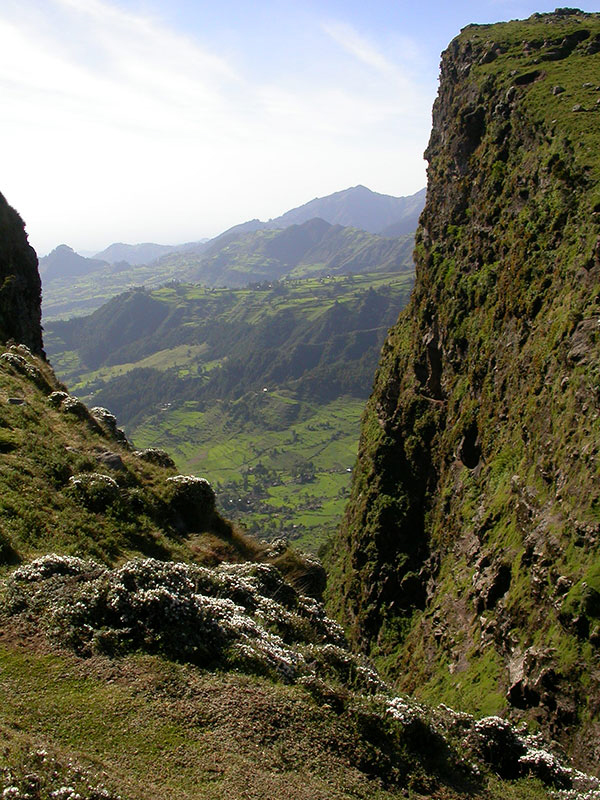
Day 3 - March 12
We were headed for the famous Awash National Park, and to get there we returned to Addis Abba to pick up highway 4. That was a very long drive, and we did not arrive until dark. I preferred not to drive at night, as it was very dangerous with all the big trucks barrelling down the highway. Ethiopia is landlocked and almost everything came inland from the port of Djbouti. There is an old railway, but it can only handled a small part of the traffic. After seeing a few terrible accidents, I asked Meseret to make sure, we did not drive at night anymore.
We checked into an old-fashioned hotel, but at least the bathroom was working and they had a good restaurant.
I did not sleep too well because of the strange sounds behind the hotel. The next morning I found out that the town’s garbage dump was behind the tall wall at the rear of the hotel, and the strange sounds came from the local hyenas dining.
We saw 98 different species during our travels.
"Rosy-patched Bush-Shrike courting in Awash National Park © Brendan Sloan"

Day 4 - March 13
We had an early start for birding in Awash National Park. On the way we saw Antelopes, Jackals and Kori Bustards, and when we arrived at the gate, we were assigned an armed guard to escort us. We were told that the guard was necessary to protect us from the wildlife, but I think it was more about the infamous Afar tribe still living in the park with their cattle. It turned out Meseret had worked in the park for eight years and he knew everyone. The birding was quite good, and we saw our first Bateleur Snake Eagle, Helmeted Guineafowls, Crested Francolins and many Kori Bustards (some of them displaying and one flying which is quite a sight, since it is the world’s heaviest flying bird). We also saw three kinds of Hoopoe, Eurasian, Black-billed and Abyssinian Scimitarbill.
For lunch we stopped at a research center run by Mark, an Australian studying baboon groups in the park, and we met his housekeeper, who turned out to be Tariku’s, sister. Tariku was born in Awash NP, but a visiting Swedish professor decided to
send him to school in AA and paid for his education.
We saw 80 species of birds
Day 5 - March 14
We birded in the park all day, and this time we do not need our armed guide. As soon as we entered the park, we spotted our
first hyena, crossing the trail ahead of us.
In this part of the park there were several small Afar settlements, where people live as they have done for thousands of years. The men and young boys tend there livestock and topless women look after the homes and cook.
The highlight, as far as birding was concerned, was a beautiful pair of Rosy-patched Bush-Shrike singing their hearts out early in the morning. We also came upon our first Common Quails, four different kinds of Bustards and White Storks. Our first Northern Ground Hornbill also presented itself.
We went back to the hotel for a nice cold beer, dinner and a good night’s sleep under the mosquito net.
We saw 85 species today.
"Kori Bustard in Awash National Park © Brendan Sloan"
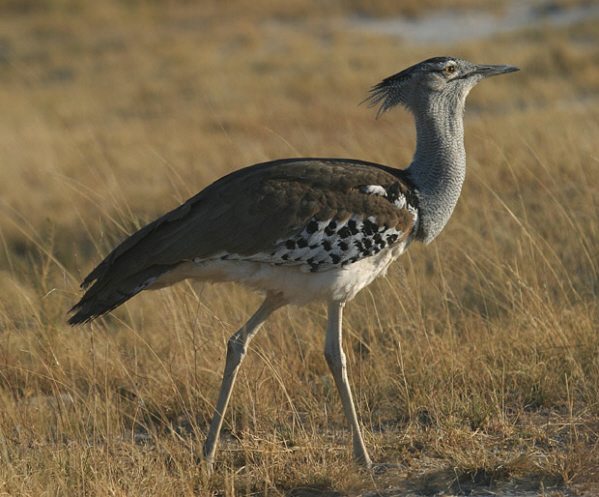
Day 6 - March 15
We birded in Awash National Park for the last time and then headed for Nazret. Birding. on the way there, we saw our first Greater and Lesser Flamingos, African and Pink-backed Pelicans, African Spoonbills and many other water birds. We spent the
night at the first western-style hotel since Addis Abba. It had plenty of hot water for showers, and a fine restaurant but there was still no luck with internet access.
We saw 106 species today.
Day 7 - March 16
We left at 6.30 this morning for the Bale Mountains. It was a very long and exhausting drive to Goba and we didn’t do much birding on the way, but we did see our first Chestnut-napped Spurfowl and a Rouget’s Rail.
We also had a very good look at a roosting Verreaux’s Giant Eagle-owl until the kids from a nearby compound spotted us. One
11-12 year old boy spoke enough English (I was a little surprised at how many of the kids going to school could speak English), and he told me he learned it in school. Then he said “Cuba give money for pencil and paper”. He must have learned more than English at school, and he still remembered the good old days under communist rule. A smart kid and I am sure when he grow up he wont be spending his life herding livestock.
The accommodations were not bad and again, we had lots of hot water. The four of us were getting along pretty well. Tariku, who did not look like the average Ethiopian, but rather like a Jamaica Rastafarian, and I had a little game, we played, when we needed to find each other. I would just ask the staff “where is the faranji?” and they knew right away, who I were talking about.
Today we saw 68 species.
"The endemic Ethiopian wolf's mountain home."
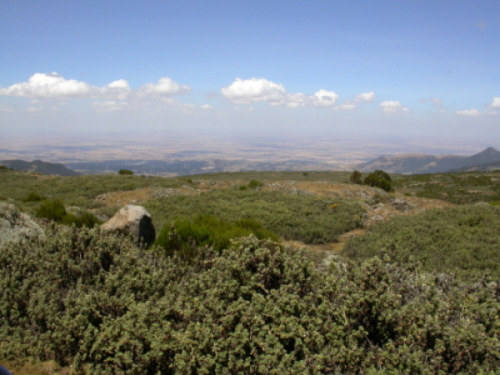
Day 8 - March 17
We left for the mountains (4200m), not just in search of birds, but also the rare and endemic Ethiopian wolf and hare. When we arrived, we were lucky to spot seven wolves, and even one hunting for a hare too (no luck for the wolf this time), but there
were also plenty of rodents all over, a smorgasbord for raptors. On the way up the mountains we spotted a beautiful Golden Eagle circling just above our heads. Next, we saw a Tawny Eagle by the side of the road which was not about to give up its Wattled
Ibis meal for us. We were within 10 feet and it still ignored us. We had a very close look at a beautiful Lanner Falcon sitting on a post 20 feet away, and that was also a great thing to experience. We didn’t even need our binoculars to see it.
Today we saw 95 species of birds.
Day 9 - March 18
We were planning to visit Soformar Cave at the lower Bale region, looking for Bristle-crowned Starling and Salvadori’s Seed-eater. We did see the Starling, but we had no luck with the Salvadori.
The cave was interesting because it was formed by a river that literally disappeared into the mountain and it was a gathering place for the tribal people to bathe and for their livestock to drink. Meseret had to negotiate the fee with the local chief,
but he was good with such things, since he spoke a number of tribal languages. If memory serves, he was also born not too far from Bale, and, therefore, had extensive knowledge of the locale and people.
We spotted mating Yellow-spotted Rock Hyraxes, which was also a somewhat unusual sight.
The roads in this part of the country are simply dirt tracks, but were good for birding and we stopped and birded along the way.
When we returned to Goba, I tried to use the internet again without much luck and decided to forget about it for the rest of the trip. I did buy a phone card and borrowed Meseret’s cell phone to call home to say that all was well in the mountains and found out they were shovelling snow in Toronto.
Today we saw 73 species of birds.
"Sofomar Cave(lower Bale region) - Home to Bristle-crowned Starling and Salvadori's Seed-eater"
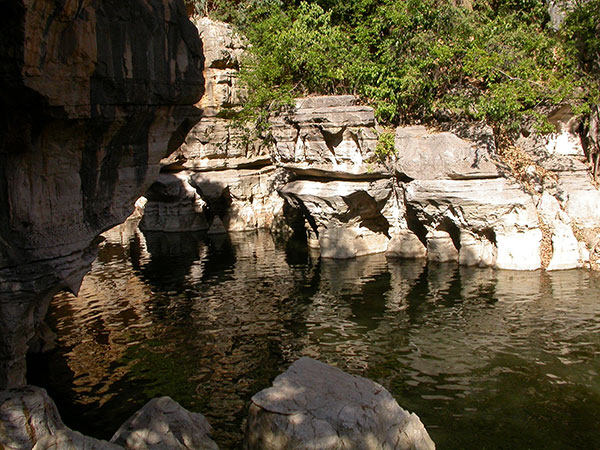
Day 10 - March 19
We left early this morning for a very long drive on dirt roads to Negele, in search of Ruspoli’s Turaco. As soon as we got up in the mountains, we were met with the unexpected sight of snow covering the ground.
Upon our arrival late in the afternoon, we found our hotel occupied by soldiers on leave from the Somalia occupation and no
rooms for us, even though we had made reservations ahead of time. In such a small town, there was not much lodging. We had a choice of the four of us sleeping in the 4WD or taking rooms in a local bordello Meseret managed to find. The rooms were very small, containing only a bed, a chair and a single blue bulb in the ceiling. Well, that was still preferable to four grown men sleeping in a vehicle, so we took the rooms. We ate at the restaurant in the hotel, where we should have stayed, and had a nice dinner. When we returned to our rooms, a serious party was underway, with drunken soldiers playing loud music. At midnight,
after they had been playing the same Ethiopian hit tune over and over, I had finally had enough and went outside in my
underpants and started yelling at them to turn down the music. It was quite a sight to see the young soldiers looking in amazement at the yelling faranji, but they did turn off the music, and I could then go to sleep. With the exception of a screaming woman, and the arrival of military police half an hour after, the rest of the night was silent until the mullah
started his call for prayer the next morning.
We saw 67 species today.
Day 11 - March 20
We left early the next morning in search of Ruspoli’s Turaco. On the way, we passed by what looked like a newly dead donkey covered in vultures. After an hour’s drive we stopped and immediately found 2 Ruspoli’s in trees close to the road. We had a
very good look at this endemic bird and shortly after that, we were joined by two young shepherds armed with spears, wanting to know what we were doing. Meseret spoke to them in their own language, and I offered them the use of my binoculars, so they could see what we had been looking at. They probably thought we were crazy faranjis, but Meseret told us that he was always trying to tell the tribal people to protect the habitat, so crazy people can come and spend their money to see the wildlife.
This area was tribal land and known for robberies, kidnappings, and worse. Meseret and Tariku are on high alert. As I was
walking back to the 4WD I heard them talking to each other in Amharic, but in a different tone than normal. I asked what was wrong and Meseret pointed to the hill where several men with AK47’s were approaching us. “We have to leave right away” Meseret told me, and I shouted to Brendan, who was blissfully looking for one of the little brown birds, we were still missing. There
was no reaction, so I shouted and told him we were leaving and he could deal with the guys who were coming down the hill. That got him moving, and we left quickly and decided from then on, when Meseret said it was time to go, we go, and ask questions later.
I do not think Ethiopia was more dangerous than many other places in the world, but it was important to have good people as guides in tribal areas. A week before I arrived, several English and French tourists were kidnapped close to the Eritrean
border, and it took weeks to get them released.
Upon returning to Negele, we passed by the last resting place of the donkey, but not a bone was left. Perhaps the hyenas
assisted the vultures in cleaning up the carcass.
The soldiers who had commandeered our hotel have gone back to war, and we have our rooms with hot water back in time for a much needed shower.
Lunch today is injera with roasted lamb: pretty good, and spicy accompanied with a cold beer. Coming from Toronto I was accustomed to food from around the world, and I like most of it (even cook some of it myself) but Ethiopian food will never be
at the top of my list. The beer was good, the coffee was great and the wine was potable, when available, but the food was
just food.
This area was great for birding, but the logistics were quite difficult, as there was little infrastructure. This was the place for little brown birds and we spent much time trying to identify them. Both Brendan and Meseret were pretty good, and we did manage to see Foxy (Abyssinian) Larks and many more, but had no luck with the Dagodi Lark, but who knows, maybe we did see them, since they were very hard to identify. We did finally find Somali Short-toed Larks in grassland close to a military base. Soldiers were not a problem for us, but a Canadian couple we spoke to at the hotel, had had some difficulty with them. The main problem we had was an abundance of mites just waiting to jump on us as we walked through the grass.
We went to bed early, as the power went out at eight o’clock. It did not come back on until the next day, and I finally had good use for the flashlight I had lugged around with me.
Just remembered that Tariku got quite exited, when he got a cell phone call from a friend telling him his name had made the New York Times with an article written by and American journalist, he had guided a couple of month ago. Not easy to have a driver that is so famous.
Today we saw 67 species of birds.
Day 12 - March 21
We slept well under mosquito nets (this is malaria country) but were up at 5.30. There was no breakfast or hot water. There was no power, so we left for Yabelo, a 250 km trip on very dusty dirt roads.
Upon arrival, we checked into our hotel, the only one in town, located on the highway to Kenya. We birded the mountains nearby and found our last Turaco (Bared-faced) of the trip.
The restaurant and hotel were good.. I did discover that the cat patrolling the restaurant was no pet. I almost lost a finger, when I tried to pat it.
Today we saw 79 species.
"Vulturine Guineafowl around Yabello areas © Brendan Sloan"
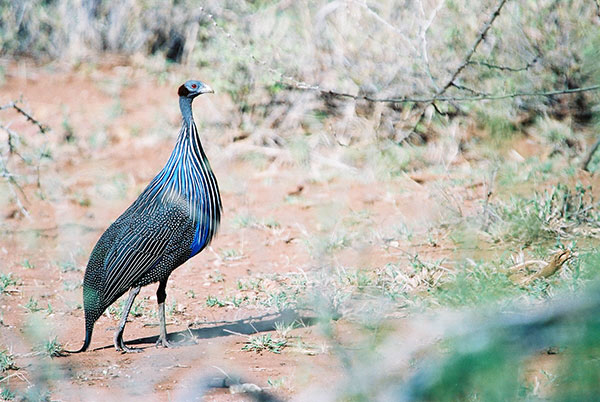
Day 13 - March 22
We started out early, looking for Shrikes, Starlings and the endemic White-tailed Swallow.
We went back to the hotel for lunch. The sun was pretty strong at midday, so we rested and then went back out birding. It was Brendan’s day for photographing African Starlings.
Today we saw 89 species of birds.
Day 14 - March 23
It was along drive today to reach Wendo Genet (360km), but it was a paved road with many small villages on the way. People, bicycles, carts, trucks and livestock made it a slow drive, and Tariku earned his money today. We stopped for lunch in Dila, and a small boy came over to our table and asked if he could sit down and practice his English. He was in grade 8 and English was
his favourite subject. When we left, his mother came over and thanked me for taking time to speak to her son.
In the late afternoon, we arrived at the lodge where we were going to stay. It was located in one of Emperor Haile Selassie’s
old country estates, and its architecture was left over from the communist ere, but there was plenty of clean, hot water from nearby springs. There were not many guests, but they had a nice restaurant.
We saw lots of monkeys in the trees and did some birding on the grounds. Today, we also saw our first and only Somali Bunting
and a very cute African Pygmy Falcon.
Today we saw 80 species of birds.
"Local farm."
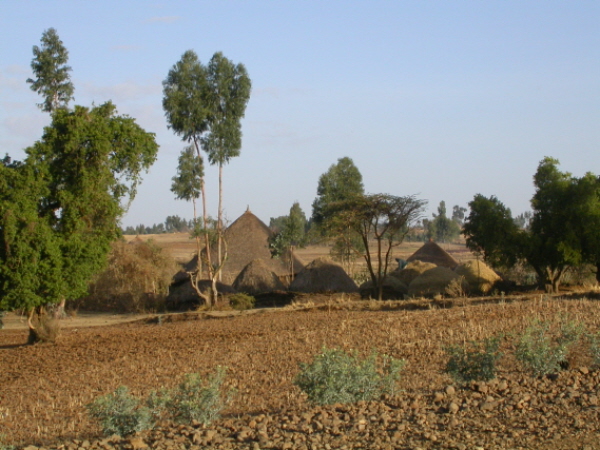
Day 15 - March 24
We birded early for Half-collared Kingfishers at a forest stream nearby and found it.
After a breakfast of plentiful fresh fruit, we packed our suitcases and headed for Langano Hayk, a resort located on the shores of Lake Langano a part of the Riff Valley lake system. We tried to bird on the grounds in the afternoon but heavy rain and thunderstorms moved in.
The power was out, so we dined by candle light and went to bed early.
Today we saw 51 species of birds.
Day 16 - March 25
Our destination for today was Awasa, one of the largest cities in Ethiopia. On the way we stopped at Lake Abijata to see tens of thousands of Greater and Lesser Flamingos. There used to be many more, but it was still a fascinating place, with many migrant shore and water fowl also present. When we got there, the lake had shrunk to half its normal size, and we were walking on a
crust that felt like rubber. It occurred to me that if one of us broke through that hard surface, he would have just disappeared.
This has apparently happened to cars which were not familiar with the trails.
We were staying at the Awassa Wabe Shebelle resort, the best place so far outside Addis Abba, even though my room got invaded by thousands of tiny ants, and I had to call the staff to come and spray.
We birded the lake in the afternoon and found many African Pygmy Geese and other waterfowl. A colony of nesting Marabou Storks
in the garden kept the grounds clear.
We had fresh fish and white wine for dinner and then went back to the room to watch BBC news for the first time in days.
Today we saw 99 species of birds.
"Fishing Lake Awasa."
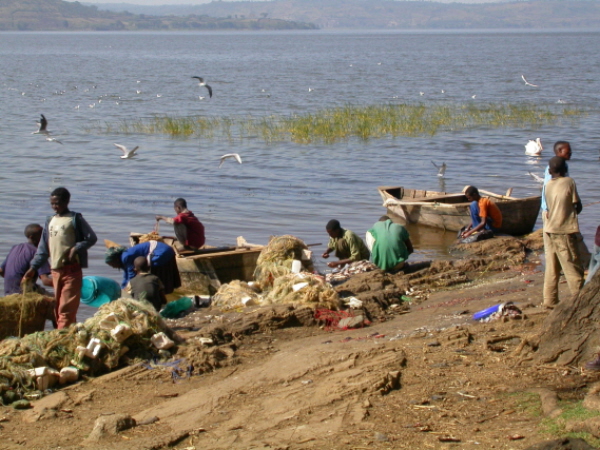
Day 17 - March 26
We were up early to look for Spotted Creeper on the resort grounds, but had no luck, so we birded the lake again.
After breakfast we were off for Addis Abba, stopping by lakes on the way. We saw Black Storks, Black-tailed Godwit and many more shore and water birds.
Upon getting closer to AA we were back in civilization, marked by terrible traffic and bad air. There was definitely something
to be said for tribal lands and dusty trails.
We were back at the old Ghion hotel.
Today we saw 91 species of birds.
Day 18 - March 27
We birded first thing in the morning in the hotel grounds, and then I packed my binoculars away for this trip.
I ate an Ethiopian “pancake” dinner with Brendan who is leaving tonight.
Day 19 - March 28
I checked out of the hotel and Meseret picked me up .We were going to do a little shopping and Meseret made sure the merchants did not take advantage of me.
Later on we met Tariku for drinks and food and they dropped me at the airport for my long trip back to Toronto.
In total we saw 419 species of birds, including 23 endemic or near endemic.
Ethiopia was not a disappointment, even if we had to rough it from time to time, and I would very much like to come back to see what we missed, most especially the north. Not only was the birdwatching great, but also the stunning nature we came upon time and time again.. I enjoyed the people very much. Meseret and Tariku helped to make this trip was successful and safe, and also the many others we met during our journey.
Here is a note I picked out from The Ethiopia Reporter, a local newspaper you may want to read.
The pulse of Ethiopia
By K. Giratta
A traveler went across the country to get underneath the surface of Ethiopia, peel back its layers and see what lies beneath –
in search for the essence of Ethiopia.’ Seeing is believing’, the big billboard read with a picture of new luxurious houses. In front of it, a man was lying lifeless on the street. I was walking on the streets of Addis Ababa searching for the essence of Ethiopia. I looked around.
Addis Ababa is a city of contrasts: new commercial buildings alongside shacks, donkeys alongside Lada taxis and beggars
alongside business professionals.
Contrasts may bring dynamics to Ethiopia, but is it really the pulse of the country?
I decided to travel outside Addis to see if I could find the essence of Ethiopia. I was driving on a dry dusty road. I was heading for the south. The air was filled with black smoke from the exhaust of the car in front of me. Farmers and children were walking alongside the road. They were carrying heavy bags.
The wind was playing with the sand, creating a small tornado that built up and danced across the fields. I passed some villagers who were busy pumping water from the ground.
I arrived at a random town. I could hear loud music from one of the restaurants. I decided to have a look. I entered the room. I was greeted with the known smell of spices and roasted coffee beans. People were dancing a traditional dance. Their bodies moved freely to the beat of the music.
Culture may add spice to Ethiopia, but is it really the pulse of the country?
Next I went to Harar. I navigated through the labyrinth of Harar through the narrow alleys. I noticed a mosque and a church that were side by side. I went to the markets; ‘vegetable market’, ‘recycle market’ and ‘smuggling market’. I could smell the aroma
of spices. A young boy was standing on a pile of plastic shoes and was sorting out the blue plastic shoes from the green ones. I looked at the crowd in the markets. People were chewing chat.
The women wore colourful dresses that shined in the baking sun. There was a mixture of Afaris, Oromos, Hararis, Somalis etc... Ethiopia has a rich cultural diversity with its 80 different ethnic groups and 84 different languages.
Diversity may add colour to Ethiopia, but is it really the pulse of the country?
I stopped the car on the outskirts of Dire Dawa. A little girl caught my attention. The flies were all over her face. She was sitting on a pile of trash. The people here were living in the middle of a trash compound. The smell was assaulting. The flies kept hovering over the place. Some people were living in tents while others had no shelter at all. A man lay lifeless on the ground in the merciless sun. I was facing the raw reality of poverty. It is estimated that 39 % of the total population live below the poverty line.
Ayub Abdureman, 20, said: ‘Life is hard here.’ He looked down and paused. ‘I eat once a day. Not enough food.’
Poverty may bring perspective to Ethiopia, but is it really the pulse of the country?
Next I was heading north of Addis. I was driving on the open road. I could see the silhouette of the mountains rising majestically in the distance. The sun was rising. I got out of the car and sat down. I looked at the mountains stretching as far as the eye could see. I took a deep breath and inhaled the fresh air. No traffic jams. No people. No noise. I could only hear
the wind whispering. The place was tranquil.
Ethiopia has many national treasures: historical sites, national parks, lakes and mountains.
Scenery may add personality to Ethiopia, but is it really the pulse of the country?
Then as I was heading back to Addis, it suddenly hit me: the people; their smiles are the pulse of Ethiopia. Everywhere I had been the people had been smiling, not only smiling, but smiling a lot. Even the people who faced poverty, deprivation and hardship were still smiling. I talk about the real genuine smile that reflects in the eye.
They are the ones that make the country beat. They are the ones that bring vitality to the country.
Ethiopians may not be wealthy in ‘material’ terms, but they smile a lot and that makes them wealthy within. I had finally found the pulse of Ethiopia; A land of smiles.
‘Seeing may be believing’ as the billboard read, but sometimes, we become blind by the familiar, and we have to open our eyes again. There is a saying, ‘it is not what we believe that counts but the act of believing’.
Last update 29/10/2012